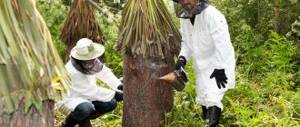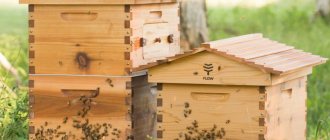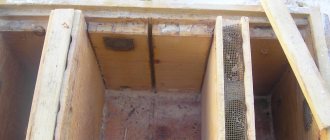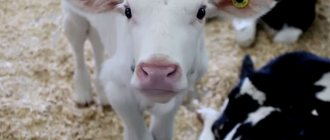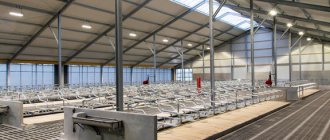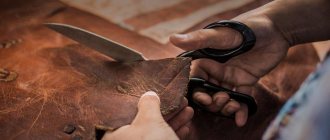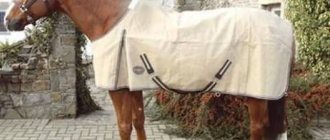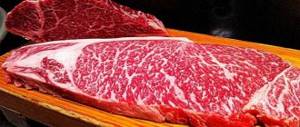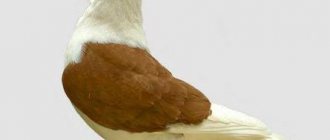Apiary in spring
There is no more beautiful image in the beekeeper’s imagination than an apiary in the spring. And very soon this long-awaited time will come. This is a holiday not only for the bees themselves, but also for their owners. But, unfortunately, it is not for everyone. It can only be real or complete if all bee colonies have overwintered successfully.
First of all, it is necessary to ensure a safe first flight for the bees. If they winter in the wild, then prepare the area near the hives in advance (clear it of snow and ice). If in an omshanic area, then after clearing the apiary of snow in the spring, they set up an exhibition of bees.
There is no point in delaying this event too much if the beekeeper is interested in creating strong colonies and working them on early honey plants. Every year in the same area, the first cleansing flights occur at different times. A beekeeper practically cannot predict in advance when this will happen this or next year.
As a rule, for bees this action occurs spontaneously. When there is too great a need to cleanse the intestines, then a slight clearing of the sky for 1 - 2 hours and warming the air to +5 - 10˚C are enough.
Sometimes bees make partial, single flights even at lower air temperatures and return safely to their hive. But it happens that, at low temperatures, some of the bees do not have time to return home and die.
A novice beekeeper should not be concerned about the slight death of frozen bees. Thus, the problem family gets rid of a large number of sick individuals. This significantly reduces the degree of infection and infection of the entire hive. Correct placement of hives primarily affects the life of the apiary in the spring.
Placing bee colonies in a sunny, cozy place, protected from all winds, significantly increases the theoretical ability of bees to perform cleansing flights. Sometimes, they can occur during winter thaws, which significantly improves the life of bees in winter.
But the greatest probability of the first flights is possible at air temperatures of 10 - 12˚C and above.
After such warming, the bee colonies become significantly more active (they clean up the waste, more seeding appears). Then, after a few days, if the weather is warm, the beekeeper must conduct a spring inspection of the bees. Correctly and timely implementation of the event affects the development of bees as a whole.
During its implementation and in the future, the beekeeper can eliminate many factors that affect the development of bee colonies and their strength.
Wintering and spring revision
In order to preserve the integrity of the hive and the entire bee family until the next season, the process of wintering and spring revision must be approached responsibly. First of all, you should take care of the ventilation inside the houses. If this is not done, dampness will appear in the hives, which is harmful to insects. The condition of the bees is checked once every 2 weeks. They must have enough food left; if it runs out, the supplies must be replenished.
Winter
Some breeds of bees spend the winter in special houses - omshaniks. You can make them yourself, depending on the size of your family. They are required for such breeds as: yellow, Caucasian, Ukrainian steppe, Carpathian. Central Russian bees spend the winter quietly in outdoor hives. You just need to take care of comfortable conditions inside the houses.
With unstable temperatures in the region and sudden jumps from above-zero during the day to severe minus at night, it is advisable to keep even well-adapted bees in an omshanik.
Advantages of keeping insects in a winter hut:
- bees consume less food;
- the service life of the hives increases;
- You don’t have to worry about temperature changes and the death of insects.
Spring
After a successful wintering, when the weather improves and frosts are not expected, the hives are placed in their usual place. As a rule, this happens in April-May. In central Russia, the indicator is the beginning of dusting of gray alder and hazel catkins. There should be several audits: the primary one, during which a quick inspection is carried out and shortcomings are eliminated, and the main one.
An experienced beekeeper will demonstrate how the first spring inspection of the apiary goes. Watch the video:
During the main inspection, which is preferably carried out in calm, sunny weather (the temperature in the shade should not be below 15 degrees), the beekeeper carefully studies the bee colonies, identifies shortcomings and corrects them in a timely manner. It is recommended to keep a record where during the inspection all data obtained is recorded.
The beekeeper must find out:
- The presence of a uterus in the family and its quality (is it sick).
- Number of brood.
- The total number of individuals (whether there are enough of them to feed the offspring).
- Availability of feed supplies.
The revision process includes repairing frames, removing damaged combs,, if necessary, reducing the nest and replenishing food supplies, and replanting a new queen (if the old one did not survive the winter). A little later, when the weather has settled, the beekeeper must completely clean the nest and disinfect the hives. The strength of a family can be determined by counting the number of individuals. If insects occupy at least 6 streets in the hive, this is about 1.5-1.6 kg of bees, such a colony will develop well in the spring and guarantees good honey production in the new season.
Having taken into account the tips on beekeeping and having received a successful first harvest, the beginning beekeeper must constantly improve in a new business. Without knowledge you cannot succeed. By updating information about the life of bees, listening to the advice of experienced colleagues and purchasing modern insect care products, you can eventually become an experienced beekeeper. Today, this activity is still in demand, and a significant segment of the industry remains with novice beekeepers.
0
0
Copy link
Features of the development of bee colonies on the approach to spring
To get the maximum amount of honey, you need to carry out all spring work with bees as quickly as possible. They include:
- bee exhibition;
- checking and replacing hives;
- feeding;
- assistance to families who are left without a womb;
- hive expansion;
- strengthening of branches and removal of the uterus.
In order for all the work to be completed correctly, you need to know the vital functions of bees. With the beginning of spring, insects become more active. This can be detected due to increased noise in the hive. During this period, it is important for the beekeeper to ensure that the room in which the bees overwinter does not heat up ahead of schedule. Otherwise, the swarm may fly out, which will lead to death.
In early February, the queen produces brood. This is necessary to prepare a shift of bees before the honey plants begin to bloom. If insects have enough food, they will survive the winter well. But if there is not enough food, the bees will begin to leave their houses ahead of time. This may negatively affect their health.
What do bees need to provide?
The house in which the bees live serves as protection from the weather on rainy, cold or hot days. Insects feed, breed, and overwinter here. It is important to provide bees with a strong and clean hive - this will form the basis of a healthy and productive bee colony.
Be sure to read:
Syrup for bees: feeding all year round, how to cook it, what to make it from, inverting sugar
If a swarm is left without a queen, it is combined with another family. The queen plays an important role in the life of bees. She lays eggs from which young individuals hatch. Without a queen, the swarm is doomed to quick death, because the lifespan of a worker bee is about 45 days.
Bee colonies are given food - sweet syrup and honey: this stimulates active reproduction and an increase in working insects. Bees need additional nutrition in the spring (before the honey plants bloom), in the summer (before the start of collecting honey from raspberry fields) and in the fall.
At the end of the season, feeding helps increase the number of wintering insects. They must survive the cold season and raise the younger generation.
Caring for bees in spring
With the arrival of spring, the beekeeper will have to perform many different tasks in order to get rid of the negative consequences of wintering. He needs to take care of creating favorable conditions for the development of his pets. Usually, the first spring work in the apiary is carried out during the bee exhibition period. This event marks the beginning of the spring-summer beekeeping season.
At this time of year, a period of special activity begins for the beekeeper. At the same time, as beekeeping implies, spring work in the apiary should be carried out as quickly and correctly as possible.
In order to achieve the desired result, it is recommended to plan your actions in advance. Spring work includes the following procedures:
- Bee Exhibition;
- Examination;
- Replacement of nests, their cleaning and reduction;
- Stocking food;
- Help for bee colonies that have become weak over the winter, as well as for families that have lost their queen;
- Enlargement of hives;
- Construction of new cells;
- Strengthening layering;
- Removal of queens;
- Installation of the second building for strong families.
As you can see, there is really a lot of work to be done. To carry it out in full, you should know about the peculiarities of the life activity of bees during this period.
When they wake up
In spring, insects are more active. For this reason, it is quite common to hear noise coming from hives. It is worth making sure that the room in which the bees were located in winter does not heat up ahead of schedule. Otherwise, they may fly out, which brings with it negative consequences, including mass death.
Therefore, it is extremely important that the insects receive all the necessary conditions for the first flight to be successful. In addition, this is necessary for their recovery after a nap. During this period they require the following conditions:
- The first flyby is carried out perfectly at a temperature of about ten degrees.
- In the case when you put the houses out of the shelter, you need to wait for the temperature to reach 12-15ºC. This will allow the bees to safely survive possible repeated cold snaps.
- It is necessary to monitor how the bees get rid of the waste accumulated in the intestines over the winter. This way you can identify diseased insects. As a rule, they do not leave their home to achieve this goal.
- If the weather is sunny, the bees begin to become more active and quickly return to their usual way of life.
- With the onset of spring, the queen bee begins active oviposition. This helps to increase the number of individuals and strength of the entire family.
- At this time, it is extremely important to monitor the temperature inside the houses. She must be tall. Therefore, you should not disassemble the hives or remove the entrances from them too often. Particular attention in this matter must be paid to weakened families.
Design of a homemade and factory pollen dryer
Based on this, we can say that the awakening of bee colonies occurs depending on weather conditions. Therefore, it is impossible to give a specific date. You just need to carefully monitor your pets when the thermometer reaches +10ºC.
When you are sure that all the bees are in good condition, spring work in the apiary can be considered successfully completed.
Early spring work in the apiary and preparation for flight
However, for the first time, a novice beekeeper conducting spring work in an apiary should not rush and interfere with the life activity of bee colonies. After wintering, they are quite vulnerable, they do not tolerate temperature changes, outside interference and daylight. Use a red light in the room where the hives are located, and perform actions inside the hive quickly and painlessly for residents.
What activities will be truly useful and timely? How to properly arrange the spring apiary?
A video for beginners about where to start in the apiary in the spring months will help you avoid annoying mistakes and help you prepare well for the new season and honey harvest.
The first thing bees do when the weather warms up is cleaning the cells for future eggs. As a result of increased processing of beebread and honey, the insect body produces additional waste.
In such a situation, until the bees fly out of the hive, both overly active intervention and ill-conducted feeding are dangerous.
Cleansing flight and family audit
After flight, an experienced beekeeper easily receives information about the condition of the bees. The more active the insects are, the better they overwintered, and at the moment they are freed from excrement accumulated during the winter.
Weak bees cannot rise high enough, and sometimes they remain on the walls or entrance altogether. This situation is most often observed in several cases:
- over the winter the family was left without a queen, and now the insects are in a kind of confusion;
- there was little food in the hive and the insects became weak over the winter;
- the population of the hive is sick with nosematosis or has been attacked by mites.
If during the first flight the beekeeper identifies such problem families, the schedule of spring work in the apiary must include checking the condition of all nests and cleaning them.
All kinds of debris that has accumulated during the autumn and winter months, as well as all honeycombs with signs of mold, must be removed. To prevent death from causing the spread of infection, it is buried or burned. In place of defective frames, the beekeeper puts spare frames with honey, thereby taking care of members of weakened families. Do not forget about checking and restoring thermal insulation that has worn out over the winter.
Since the hives already have brood by this time, all work in the apiary in May and other spring months is carried out very quickly and carefully so as not to chill the hive. Families that have lost a queen need to be completed by introducing a queen into the hive in a cell from the nucleus.
For novice beekeepers and anyone interested in beekeeping and spring work in the apiary, a video on this topic will allow them to better understand the sequence of operations and clearly present all the nuances of each stage.
Methods and tips for keeping bees
If you divide the work in the apiary by season, you get the following:
- Summer is a time for active collection of food supplies, reproduction of insects, and layering.
- Autumn is the period when it is recommended to raise young bees, strong and strong, capable of surviving until spring.
- Winter is a time of rest, when insects are half asleep and eat food reserves. Closer to spring, the uterus begins to turn scarlet. In the brood zone, the temperature must be maintained at least 14 degrees, the optimal temperature for the larvae is 34. The winter hut lasts from the last to the first flight, from November to March.
- In the spring, new individuals develop, families increase in strength and begin to reproduce.
As with any business, beekeeping has its tricks. To make this activity not only a pleasant hobby, but also a profitable business, it is recommended to use the following tips for raising bees. First of all, inexperienced beekeepers must decide on a breeding method. They are divided into three types (starting with the simplest, suitable for beginners in this matter):
- Half a flight . One family (it must be strong) is divided in half and placed in different hives, which are installed at a distance. A new young individual is introduced into the family that is left without a queen.
- Individual layering . Several frames of brood and adults are removed from the hive and moved to an empty house standing to the side. The family is strengthened after the brood appears, several new frames are added.
- Layerings are temporary , used only before the start of honey collection. New individuals are placed in one part of the multi-hull hive; after the first honey, old and young individuals are combined. The family becomes stronger.
It is important to know that keeping families separate is only possible if there is a good honey collection near the apiary. The survival rate of insects increases and the quality of honey improves.
Useful recommendations for the beekeeper:
- the apiary should always have a supply of queens necessary to replace sick, old, and deceased individuals;
- young queens are needed to expand the apiary;
- in the absence of honeycombs, the queen loses up to 600 eggs, you should not be late with the move;
- Strong bee colonies are less susceptible to developing diseases and winter easier.
Beginner beekeepers will benefit from advice from experienced beekeepers. A specialist will tell you more about how to breed bees. Watch the video:
Insect development in spring
At the beginning of the last winter month, the queens begin to produce brood. This allows you to prepare a shift for the family in advance, even before the honey plants begin to bloom.
Insects survive the winter safely if there is sufficient food and ventilation of the hives. The number of bees killed during the winter in this case is insignificant. However, if there is an acute shortage of food in the home, then the winged workers begin to get out of it too early. Such haste can have a detrimental effect on their health.
In general, spring is considered to be a period of increased bee activity. It is then that preparations take place for reproduction, increasing the strength of families, as well as breeding new queens. For the most part, this depends on the beginning of flowering of honey plants. Insects begin actively collecting honey and recovering from winter dormancy.
Feeding and preventive work
A caring beekeeper always monitors the condition of his charges. If there is a lack of food in the nests, you should resort to artificial feeding. As an additional food, you can use cakes made from powdered sugar and candied honey. The cake is wrapped in sterile gauze and covered with film. Place this delicacy on frames.
In addition to providing pets with additional nutrition, it is important to take care of the issue of preventing diseases and parasite attacks. The beginning of spring is considered the most suitable period for this, since at this time possible pests and pathogens are passive. Here is a list of recommendations for carrying out preventive procedures in the apiary:
- You can add fumagillin to the prepared cake for feeding. It has a beneficial effect on bees when signs of nosematosis are detected in them.
- To prevent varroatosis, dill oil is added to the sugar syrup.
- To increase the immunity of insects, add a little decoction made from pine or spruce needles to the food.
Opportunities and advantages of log beekeeping
In order for even a novice beekeeper to understand how to care for bees in the spring, the video will demonstrate all the intricacies of this matter clearly.
Exhibition of hives from winter hives
Spring work in the apiary begins with the exhibition of hives from the room in which they stood in winter. The location should be chosen carefully. It should be dry, protected from the wind, away from buildings with other animals, from living quarters and roadways. The approximate distance between hives is 4 meters, but it is acceptable to reduce it to 2 or 3 if the area is not too large. This is done so that the bees do not lose their bearings and return to their house. To make the task easier, the hives are painted in different colors.
The area is first cleared of debris, branches and snow. It is recommended to do this with ash, as it speeds up its melting. Straw or roofing felt is laid out in the apiary area to prevent the bees from landing on the cold ground and catching a cold.
After this, the beekeeper installs the hive stands at a slight angle. Car tires are often used for these purposes. It is recommended to directly place bee houses outside when the temperature is not lower than 14⁰C. If it’s too stuffy in the winter hut, you can do this earlier. The hives must be removed with the entrances closed.
After wintering, bees are in an excited state, so before releasing them for the first flight, they wait until they calm down. The hive is first heated, and a frame with warm honey and beebread is placed inside. The houses are opened one at a time, not all at the same time, starting with the noisiest families.
Exhibition and flyby
As soon as warming begins in March and early April, the bees’ homes are carefully moved from the premises to a prepared area. If low temperatures persist for a long time, it is allowed to display the hives from the winter hut to the greenhouse so that the bees can fly around and begin to actively increase the number of the swarm.
Before opening the entrances, they are cleaned of bee excrement and debris. By the presence of traces of diarrhea, one can judge the problems that arose during the winter and the need to take remedial measures.
For reference!
The first spring flight of bees is carried out with the aim of cleansing the intestines of accumulated feces. It is necessary to monitor how actively and cooperatively the insects leave their homes. Already, weakened families are being identified that require special control and care.
The beekeeper needs to note swarms that are not doing well after wintering:
- having many infected insects (with swollen abdomens, protruding wings, unable to rise) - symptoms of disease, poisoning;
- flying slowly in a small group - the swarm is starving and barely survived the winter;
- moving chaotically along the walls of the home is a sign of loss of the uterus.
A follow-up examination is carried out for such families in the first days after the flight. They need special care and certain measures.
Bees should not be disturbed often in early spring to prevent their nests from becoming overcooled. Therefore, during the inspection, beekeepers try to carry out all the necessary measures to clean the hive and eliminate the consequences of a difficult winter.
A reminder on spring bee care for novice beekeepers after putting out the hives from the winter hut and the first flight:
- Remove empty frames (without honey, bee bread, brood), especially those soiled with feces or moldy.
- Remove insect corpses, debris, and remove water from hive trays. The entrances are cleaned as many times as they become dirty.
- Estimate the amount of remaining feed.
- Inspect families for pests and infections that cause diseases.
- Make sure that the temperature inside the hives does not decrease when it gets cold.
Multi-body hives - appearance, design
In addition, the beekeeper must take good care of the developing swarms in early spring for subsequent effective summer honey collection.
Quick Look
After completion of the flight, the number of entrances in the hives is reduced. Next, you should conduct a quick inspection of bees that fly poorly. After this, the following assistance is provided:
- eliminate the pestilence;
- install clean honeycombs;
- fill the frames with food and place them in the hives;
- after that, shorten and insulate the nest;
- leave the required number of frames;
- create favorable conditions for brood.
A quick inspection is an important procedure in the spring, when the air temperature hovers around ten degrees Celsius. It is advisable to determine in advance the approximate amount of food needed, the condition of the family and the presence of diseases. If there is a shortage of food supplies, the bees will not be able to raise brood. The optimal amount of honey products for insects is at least fifteen kilograms. If there is little honey in the combs, you need to place frames filled with fertilizing.
This inspection is carried out after completion of the cleaning flight in early spring. The procedure will be more convenient in a multi-body hive. First, remove the lower body. After this, the top one is inspected to make sure there is food and brood.
If there are no cells in the combs, there is no mother in the family. In this case, the beekeeper is obliged to attach the nucleus. On the first day of the insect exhibition, the individuality of the individuals is lost. This moment is suitable to increase the size of the family. Be especially careful when handling bee bread, as it is an important product for bees.
First quality inspection
During this period, the family will be renewed and it will gain strength. At the beginning of April it is time to collect the first honey. This is one of the most important stages of work in the apiary in the spring. It is now that the beekeeper conducts the most thorough inspection. To do this you need to do the following:
- Remove the frames from the house and inspect them carefully. If damage is found, they are replaced.
- Particular attention is paid to the amount of honey that the bees use for food. The beekeeper additionally adds it until the insects begin collecting nectar.
- With the onset of stable warm temperatures, you need to remove all insulating elements.
- If weak families are discovered, all possible measures must be taken to strengthen them. Several weakened bee colonies are combined into one in March. Only if their strength has been restored will it be possible to subsequently resettle them in different buildings.
- If there is a weak queen in the hive, it needs to be replaced. Otherwise there will not be enough brood.
It is necessary to clean the bottoms as soon as possible, as there may be dead bees in them. Mold may form and an unpleasant odor may appear. This situation causes the development of diseases. For this, it is more convenient if the hives have removable bottoms. This will help speed up the cleansing process.
After the bodies are exposed, you need to install two additional drinkers. They are placed in a place protected from the wind and warm. One drinker should contain plain water, the second should be filled with lightly salted water. To attract the attention of insects, they are smeared with honey. Providing water is a must, as if there is a lack of it, the bees will start drinking in puddles.
First inspection
The first detailed inspection in the spring is the main work of the beekeeper during this period. During the inspection, the condition of the insects after wintering is checked, weakened families are identified, and what needs to be done to help them is determined. The hives are cleaned and disinfected. If necessary, fertilizing is carried out.
A calm, sunny day is chosen for the inspection. The air temperature should be +12, +14 º C. It is necessary to prepare tools and accessories in advance so that the check does not take much time to avoid hypothermia of the insects.
Audit sequence
After removing the hive cover, the condition of the insulating pads and canvas is assessed. Wet ones with traces of mold are replaced.
The frames are carefully removed and inspected, starting with the outermost one. During the audit, the presence of a queen bee and its productivity are determined.
An indicator of productivity is continuous sowing of large areas of the frame with brood. To stimulate the scarring of the queen, frames with light brown honeycombs are added to the hive, since the queen lays better in these.
Signs of an absent uterus:
- unusual behavior of bees, they buzz loudly and take a characteristic pose - they raise their abdomen without releasing their sting;
- low activity of insects after the first flight, they fly little and do not clean the hive;
- lack of brood;
- the appearance of queen cells.
There is only one way to correct the situation - to plant a new queen from the spare ones, which the beekeeper should always have. Queen cells, if they are present on the combs, are removed.
Determine the amount of remaining feed
By this time, at least 8 kg of honey and 2 frames of beebread should remain in the combs. This amount of supplies is enough for a new generation to develop in time for the main honey harvest. If there is little nutrition, complementary feeding is necessary. The required number of frames with honey and beebread from stocks is delivered. Honey can be replaced with sugar syrup, honey satiate, kandi.
Physical condition of bee colonies
The strength of the family is assessed by the number of occupied frames. A strong one occupies 6-7 frames or more, a medium one occupies 5-6 frames, a weak one occupies 4 or less.
Frames that are not covered, as well as frames without honey and bee bread, that are dirty or broken, are removed. This ensures a more compact arrangement of insects and better heating.
Cleaning hives and inspecting bees
The hive is sanitized:
- Dead insects and garbage are removed from the bottom of the house;
- In order to prevent diseases, the inner surface is wiped with vinegar;
- All surfaces are carefully processed with a scraper or other tool, removing wax and propolis. Particular attention is paid to the corners and seams between the boards. If traces of bee feces are found during processing, more thorough sanitary treatment is required, as this may be a manifestation of a serious disease - nosematosis. In this case, the family must be moved to a reserve disinfected hive. Podmor must be collected and submitted to a specialized laboratory to establish an accurate diagnosis. The previous place of residence is treated with a 3% formaldehyde solution. It is also advisable to treat it with a gas burner flame.
Relocated insects must undergo treatment for nosematosis and other diseases. The drug Nosemacidom, intended to combat nosematosis, is prepared at the rate of 2.5 g per 10 liters of sugar syrup. The dose is calculated for 10 frames.
Warm syrup with the drug is placed in the hive. After 5 days the procedure is repeated.
The drug Nozetom has a therapeutic effect against nosematosis and a number of bacterial infections. For 10 liters of sugar syrup you will need 20 g of the substance. 1 liter of syrup is heated and placed in the hive. The procedure is performed 3 times with an interval of 4 days.
Before closing the lid, the bee house is additionally insulated. This is necessary for two reasons:
- in spring the air temperature may drop to negative values;
- for the growth and development of brood, it is necessary to maintain a temperature of +33-34˚ C. With additional insulation, insects will spend less energy for this. This is good, since many individuals are weakened after wintering.
Spring insulation of nests
Another important step in spring work with bees is insulating the hives. At the time of the first brood, it is extremely necessary to maintain an optimal temperature regime for it. In this case, the thermometer readings should remain at 32-34 degrees. To maintain this temperature, additional insulation may be required.
The most popular insulation method looks like this:
- The brood is separated by a diaphragm;
- The frames on which the food is placed remain;
- The hive is being assembled;
- The upper part of the body is carefully insulated. You can dismantle your home at the end of the spring period or at the beginning of the summer;
- After this, the nest is expanded, adding one frame per day.
Cleansing the bottoms
The next main type of work in the apiary in the spring is cleaning the bottoms. It is recommended to do this as early as possible. This is due to the decomposition of dead insects. An unpleasant odor and mold appear. In turn, this can provoke various diseases. Urgent cleansing is especially required if the bees have died from infection.
To facilitate such work, it is much more convenient to use hives with removable bottoms. This will significantly speed up the process. The cleaning operation can be carried out both in cold weather and on warm days.
Ways to increase your apiary
Beekeeping apiaries are divided into three groups. One is needed for the reproduction process, the other to strengthen the family, it can be used for honey collection.
Spring work involves cutting, insulating, and supplying food. Caring for bees during this period is very important. When you notice that the brood is occupied up to 6 frames, you need to increase the colony. So the bees will begin to swarm and lay queen cells.
Main stages of the method
- Rearrange two frames with mature brood into the colony that will reproduce. The frames should be completely covered with bees.
- The frame must be taken carefully, without affecting the queen, and placed in the hive, which is a spare one. Frames with artificial foundation are installed in the empty space.
- When the strange bees flock, the frames with the bees that remain must be placed in a new colony.
Beekeeping takes into account the fact that when a large number of hard-working bees accumulate, the whole process will improve; they are responsible for laying swarm queen cells.
When you notice larvae in the queen cell, you need to move the queen and one frame with brood to a special hive. Add frames with printed brood. The layer must be insulated, then begin to expand the nest, to do this, place frames with artificial foundation.
After a week, you will be able to notice the printed queen cell. Afterwards the family is separated. It is necessary to distribute an equal number of frames in the hives. Printed queen cells are left in all hives.
Manufacturing technology of the "Boa constrictor" hive
Monitoring the condition of the hives
Beekeeping requires constant monitoring of the queen ; if it dies, it is necessary to replace it with a new one or take a queen cell from another colony.
Subsequently, the emergence of the queens from the queen cells is checked, and after 7–10 days the beginning of egg laying is checked. Beekeeping most often uses this accelerated method, with its help you can increase your apiary. This way you can protect families from the swarming process. To increase the strength on the main bribe, it is necessary to substitute magazine housings. After the early division of the family, in late spring early summer, the family will be able to increase its strength to the main bribe. When eggs begin to be laid, you need to constantly enlarge the body with the help of frames on which artificial foundation is placed. This procedure is necessary to expand the socket. The advantage of this method is that in the end there are always strong families who actively work in the apiary.
General rules and recommendations for beginners
A new beekeeper usually faces a number of questions on which the success of the entire enterprise depends. Where to start, how many colonies to buy first, how to care for bees - these are very important points. Some answers to the questions are formulated in the following rules:
- It takes enough time to breed bees. In spring and summer, it takes at least 6 hours a week to care for several hives. On average, an experienced breeder spends 1 hour serving one family. Accordingly, as the number of families increases, time costs also increase.
- You shouldn't start with a large number of insects. You should hone your skills and acquire knowledge gradually. To begin with, 5-6 families will be enough. At the same time, it is necessary to focus on working out the main points. And after mastering them, you can gradually expand. But even with this approach, mistakes cannot always be avoided. The risk increases significantly if you immediately try to control a large apiary.
- The location for installing the hives should be selected in strict accordance with the natural habitat conditions of the bee swarm. It is advisable to place the apiary near hills or in a spacious gully, and it is important to take into account the prevailing wind direction in the region and plan a location with natural protection from it. Another significant point is that the number of honey plants should be as large as possible within a radius of 2 km from the location.
- Hives should be placed with strict adherence to distances. In the rows, a distance of 4 m is maintained between them. The rows are 6 m apart from each other. But this rule only applies if there is enough space. If the area around the house is smaller, denser placement is allowed. The solution may be installation under trees, along fences, or in specially made mobile pavilions. On average, keeping bees in hives in a limited area involves up to 15 families in an area of 3 m by 5 m.
Hives should be placed with strict adherence to distances
Quadrupling the apiary per season
Features of choosing hives
A definitely important point for a novice beekeeper will be choosing a suitable hive. Most experts advise against starting breeding in hives with a large number of frames. In addition, the type of product is also important. For a beginner, the optimal solution may be executions under the Dadanov framework. An argument in favor of such a decision could be that the majority of domestic breeders work within such a framework. This means that finding and buying the right family will be easier than in the case of Rutov hives.
Rutov products have the ability to work with housings, rather than disassembling each socket during maintenance. But this method of work is unlikely to be suitable for beginners, as it involves a number of nuances and requires a certain skill.
The Dadanovsky hive is also preferable if the breeder plans to assemble it himself. The scheme of this execution is much simpler than that of Ruth. In addition, it will require less materials.
As for the number of frames, the optimal solution would be 12, no more. This will make caring for the bees easier and will give pretty good results over time. With this width, both Rutov and Dadnov versions are performed. The first option is made for 10-12 frames. The width of the second type of products ranges from 8 to 24 slots.
Dadanovsky hive
Work clothes set
Only a few will refute the fact that a bee sting is a rather painful and unpleasant phenomenon. Therefore, caring for bees in all its manifestations is carried out in special clothing. When choosing a suitable kit, you should adhere to the following guidelines:
- It must protect the entire body, from head to toe. This is especially true for people with allergies to bee stings.
- The suit must meet all hygiene standards and be kept clean.
- It is desirable that it is convenient to use, does not restrict movement and does not interfere with free visibility.
Fabric and equipment largely depend on the region in which the breeder plans to work. In areas with a more or less mild climate, it is better to choose white clothes made of light fabric. The bees here are more peaceful and such protection will be quite enough. In the more rugged northern regions, overalls made of thick gray material are more often used. The temperament of insects in such regions is more severe.
In any case, the surface of the fabric should be smooth. If there is lint on it, the bees will get confused, which will provoke them to sting. They are also extremely irritable to the smell of smoke, alcohol, gasoline and other strong aromas. That is why the owner’s personal hygiene is no less important than the cleanliness of his clothes.
Beekeeper's clothes
Help for weakened families
A large amount of honey can only be obtained with the help of strong families. Strengthening and uniting weak bee colonies is considered a last resort measure carried out by novice beekeepers who have not yet organized the apiary correctly. Thus, families that occupy five frames (or less) are subject to correction.
In what ways can this be done?
- Preserving the family. To do this, leave as many honeycombs in the nest as the insects are able to cover. They are placed in the southern, warm part of the hive, and separated by a partition. The house should be insulated as much as possible, for example, using polyethylene. Sometimes beekeepers also use artificial heating, the source of which is placed under the nest. This helps increase the brood by 1.5 times.
- Keeping several weak bee colonies in one hive, but separating them with a partition. This promotes mutual heating and accelerates development.
- Placing a weak family over a strong one, separating them from each other with a mesh or thick fabric. The warmth from the lower bees will help the upper ones survive and become stronger. Also, sometimes a weak family is strengthened with the brood of a strong one.
- Changing hives. A weak bee colony is placed in the hive with a strong one and vice versa. However, you must first properly separate the brood, since it may be left unattended and freeze.
Ways to save a weak family
| Methods | What are the |
| Preserving an independent family |
|
| Keeping weak families in pairs using a partition | Families will exchange heat with each other, and their development will improve. When the colonies fill the entire hive, they need to be divided. |
| A weak family is placed on a nest with a strong family below | Warmth will emanate from below, this will keep the weakened family warm |
| Swap weak and strong family | This procedure should be carried out in sunny weather, when it is warm. Worker bees from strong colonies will always be able to enlarge a weak one. |
Correction of queenless bee colonies
In order for the apiary to be productive in the spring and at other times of the year, it is important to have a healthy queen in every bee colony, without exception. What is recommended to do if she died during wintering? There are two options:
- joining a queenless hive of a strong family that has one. During the union, the bees are sprayed with lemon balm syrup. But first, the fistulous queen cells are removed - such places that the bees themselves prepared for the hatching of a new queen;
- direct replantation of the uterus. To do this, the hive and the bee itself are sprayed with mint syrup, then fumigated with smoke, and the entrance is closed for one or two minutes. After this, the queen is launched inside or placed directly on the honeycomb.
If for some unknown reason the bees do not accept the new queen, this only means that there is a vicious queen in the hive (an old individual or an unproductive one). Sometimes you may not notice it right away, but you definitely need to find and destroy it.
Growing families
Spring work in the apiary is aimed at timely increasing the strength of bee colonies, which affects the amount of honey received in the end. What should you do for this?
- maintain a comfortable temperature;
- replenish honey supplies to feed the bees;
- set new boundaries to prevent the swarm instinct. From 2 to 4 frames are placed in a strong family, one each in a medium and weak family.
Brief description of work by month
Spring work in the apiary consists of several stages.
March
During cleaning flights, bees are inspected. After the completion of the flight, a general audit is carried out. Also at this time, weak bee colonies are corrected and prepared for bribes, bees are treated for parasites and diseases. On the left side of the bee house, empty hives are installed, intended for layering.
April
At the beginning of the month, a quick inspection of the hives is carried out, after which they begin corrective work aimed at strengthening weak families. After 10 days, the lower buildings in multi-hull hives are cleaned. Add feed and wax.
May
Queens from strong families are placed in the isolation ward as educators, after which layers are formed. Other families are examined and, if fistulous queen cells are found, they are destroyed.
Grafting frames are made and placed in strong families, in which the queens are located in isolators. After 3 days, inoculate frames are inspected and inoculations containing large and small eggs are removed. After 2 days, layering is intensified. After 3 days, repeat layering is done using cores, and after 4 days the entrance of the queens is checked.
Expansion and contraction of nests
In spring, it is necessary to help the bees maintain a comfortable temperature. This can be done by tightly filling the frames with bees. If the nest is large, the insects are distributed unevenly and cannot heat enough comb to raise brood. Therefore, as soon as possible after the exhibition of houses, it is necessary to carry out the procedure for narrowing the streets. They are reduced to 9 millimeters, and also leave as many frames as necessary for each specific bee colony.
Advice: you need to remove those frames that have mold, cells with drones, old honeycombs and honeycombs without honey.
When the number of bees begins to increase, more nests are needed. If this is not done on time, the growth of families will begin to slow down, so you need to set new frames approximately every five days. Expansion in the spring causes the queen to begin intensively laying eggs. Another advantage is the long absence of drone brood, and this helps to move on to arranging layering.
Tip: if by the end of spring the bees do not have enough frames, they fall into a swarming state. You can get rid of this by installing new frames with foundation, then insects will begin to build honeycombs in them.
In beekeeping, late spring is considered the time to create layering. This process is needed to separate brood frames and active insects from a strong colony. They are then joined by a new queen or the bees breed her themselves.
What to do with bees after pumping out honey
Having pumped out the last honey before it is sealed by the bees, they are busy making the final nests. Each honeycomb must contain at least 2 kg of honey.
If there is not enough food, bee colonies feed by adding honey frames to the hives or pouring sugar syrup into special feeders.
Be sure to read:
Bee attack: what to do, how to stop and prevent, methods of control


